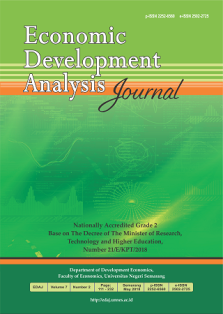Economic and Non-Economic Factors Effect Per Capita Income in Indonesia
Abstract
Indonesia per capita income tends to increase during 2013 – 2016. It indicates that Indonesian people are able to achieve welfare improvement. This research aims to analyze the effects of inflation, Human Development Index (HDI), population, Gross Regional Domestic Product (GRDP) growth, Minimum Wage, and technology utilization on per capita income in Indonesia. It becomes a reference for local economic policies at local governments in Indonesia. The estimation model uses panel data under the Fixed Effects Model (FEM). FEM is chosen based on the Chow and Hausman test. This research uses time series from 2013 – 2016 and cross-section of 34 provinces in Indonesia. The findings show that inflation and GRDP have a significant effect on per capita income with negative direction, while HDI and minimum wage have a significant effect with positive direction, whereas population and technology utilization for workers do not have a significant effect. The coefficient of determination (Adjusted R2) is about 0.999754. It means that 99.975% of the dependent variable is explained by the variation of the independent variables. The implication of policies, namely: a) the local governments should control the inflation rate; b) the local governments should increase the domestic investment in health, education, and accessibility; and c) the local governments should promote technology utilization to the workers.


